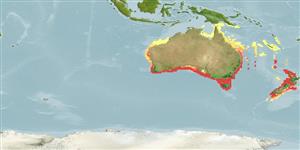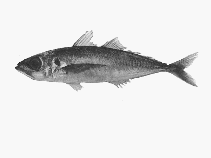Masukkan pemerhatian anda di Fish Watcher
| Native range | All suitable habitat | Point map | Year 2050 |

|
| This map was computer-generated and has not yet been reviewed. |
| Trachurus declivis AquaMaps Data sources: GBIF OBIS |
muatnaik fotos/gambar dan video
Pictures | imej GoogleTrachurus declivis
Picture by CSIRO
Pictures | imej GoogleTrachurus declivis
Picture by CSIRO
Common names from other countries
klasifikasi / Names Nama-nama umum | Sinonim (persamaan) | Catalog of Fishes(Marga, Jenis) | ITIS | CoL | WoRMS | Cloffa
> Carangiformes (Jacks) > Carangidae (Jacks and pompanos) > Caranginae
Etymology: Trachurus: Greek, trachys, -eia, -ys = rough + Greek, oura = tail (Ref. 45335).
More on author: Jenyns.
Etymology: Trachurus: Greek, trachys, -eia, -ys = rough + Greek, oura = tail (Ref. 45335).
More on author: Jenyns.
Environment: milieu / climate zone / depth range / distribution range Ekologi
laut; payau bentopelagis; kisaran kedalaman 27 - 460 m (Ref. 27930), usually ? - 300 m (Ref. 9072). Temperate; ? - 16°C (Ref. 9072); 9°S - 53°S, 112°E - 177°E (Ref. 54926)
Penyebaran Negara-negara | Daerah-daerah FAO | Ecosystems | Kemunculan | Point map | Introduksi | Faunafri
Southwest Pacific: Western Australia to New South Wales, including New Zealand. Principal component analysis of morphometric and meristic characters indicates three separate subpopulations in the Great Australian Bight, off New South Wales, and off Tasmania (Ref. 7456).
Length at first maturity / Size / Weight / umur
Maturity: Lm 31.5, range 23 - 37 cm
Max length : 64.0 cm SL jantan/; (Ref. 33839); common length : 42.0 cm TL jantan/; (Ref. 9258); Umur maksimum dilaporkan: 25 Tahun (Ref. 9072)
Max length : 64.0 cm SL jantan/; (Ref. 33839); common length : 42.0 cm TL jantan/; (Ref. 9258); Umur maksimum dilaporkan: 25 Tahun (Ref. 9072)
deskripsi pendek Kunci identifiaksi (pengenalan) | Morfologi | Morfometrik
Duri punggung (Keseluruhan (total)) : 9; duri punggung lunak (Keseluruhan (total)) : 29 - 35; Duri dubur: 3; Sirip dubur lunak: 24 - 29; vertebrata, bertulang belakang: 24. Adults are elongate and slightly compressed, and have a primary lateral line with 71-89 scutes, and a secondary lateral line reaching to below dorsal-fin rays 7-9 (Ref. 33616).
Adults are commonly found near the bottom, in midwater and occasionally at the surface (Ref. 9258) in continental shelf waters (Ref. 27930). They form pelagic schools for most of the year but may move close to the sea bed during winter (Ref. 27931). Generally found at less than 300 m water depth with temperature less than 16° C (Ref. 9072). Juveniles inhabit coastal and estuarine waters although they may sometimes be found offshore (Ref. 27930). Adults feed mostly during the day mainly on krill and other planktonic crustaceans, light fish (Sternoptychidae) and lantern fish (Myctophidae) at the edge of the continental shelf (Ref. 27933).
Life cycle and mating behavior Kematangan | Reproduksi, perkembang biakan | Pemijahan | telur-telur | Fecundity | Larva
Eggs and sperm are released amongst schooling fish, possibly deep in the water column near the edge of the continental shelf. Eggs are distributed between the surface and the thermocline and larvae are carried inshore by currents.
rujukan utama
Upload your references | Acuan | Koordinator : Smith-Vaniz, William F. | mitra
Paxton, J.R., D.F. Hoese, G.R. Allen and J.E. Hanley, 1989. Pisces. Petromyzontidae to Carangidae. Zoological Catalogue of Australia, Vol. 7. Australian Government Publishing Service, Canberra, 665 p. (Ref. 7300)
Status IUCN Red List (Ref. 130435: Version 2024-2)
kurang bimbang (LC) ; Date assessed: 19 July 2017
ancaman kepada manusia
Harmless
penggunaan manusia
Perikanan: bernilai komersial tinggi; Ikan buruan: ya; umpan: usually
FAO(Perikanan: production, profail spesis; publication : search) | FishSource | Sea Around Us
informasi lanjut
Population dynamics
Growth parameters
Max. ages / sizes
Length-weight rel.
Length-length rel.
ukuran frekuensi
Mass conversion
pemulihan
Kelimpahan
Growth parameters
Max. ages / sizes
Length-weight rel.
Length-length rel.
ukuran frekuensi
Mass conversion
pemulihan
Kelimpahan
Life cycle
Reproduksi, perkembang biakan
Kematangan
Fecundity
Pemijahan
Spawning aggregations
telur-telur
pekembangan telor
Larva
Dinamika larva
Reproduksi, perkembang biakan
Kematangan
Fecundity
Pemijahan
Spawning aggregations
telur-telur
pekembangan telor
Larva
Dinamika larva
Anatomy
Area insang
Brain
Otolith
Area insang
Brain
Otolith
Physiology
Body composition
Nutrients
Oxygen consumption
Swimming type
Swimming speed
Visual pigments
Fish sound
Diseases & Parasites
Toxicity (LC50s)
Body composition
Nutrients
Oxygen consumption
Swimming type
Swimming speed
Visual pigments
Fish sound
Diseases & Parasites
Toxicity (LC50s)
Human related
Aquaculture systems
profil budidaya air
Strain
Ciguatera cases
Stamps, coins, misc.
Aquaculture systems
profil budidaya air
Strain
Ciguatera cases
Stamps, coins, misc.
Alat, peralatan
E-book | Penuntun lapangan | Kunci identifiaksi (pengenalan) | tanda freqkuenci panjang | peringkat sejarah hidup | peta titik | Classification Tree
| Catch-MSY |
laporan khas
muat turun XML
Sumber internet
Aquatic Commons | BHL | Cloffa | BOLDSystems | Websites from users | semak peneliti ikan | CISTI | Catalog of Fishes(Marga, Jenis) | DiscoverLife | ECOTOX | Faunafri | Fishtrace | GenBank(genom, Nukleotida) | GloBI | GOBASE | | Google Books | Google Scholar | Google | IGFA World Record | MitoFish | Otolith Atlas of Taiwan Fishes | PubMed | Reef Life Survey | Scirus | SeaLifeBase | Tree of Life | Wikipedia(pergi, Cari) | World Records Freshwater Fishing | Zoological Record
Estimates based on models
Preferred temperature (Ref. 115969): 11.1 - 20.2, mean 14.4 (based on 135 cells).
Phylogenetic diversity index (Ref. 82804): PD50 = 0.5001 [Uniqueness, from 0.5 = low to 2.0 = high].
Bayesian length-weight: a=0.01259 (0.00784 - 0.02022), b=2.97 (2.83 - 3.11), in cm Total Length, based on LWR estimates for this species & Genus-body shape (Ref. 93245).
Trophic level (Ref. 69278): 3.9 ±0.61 se; based on food items.
Daya lenting (Ref. 120179): sedang, Waktu penggandaan populasi minimum 1.4 - 4.4 tahun (tm=2-4; tmax=25).
Fishing Vulnerability (Ref. 59153): Moderate to high vulnerability (50 of 100).
Climate Vulnerability (Ref. 125649): Moderate vulnerability (36 of 100).




